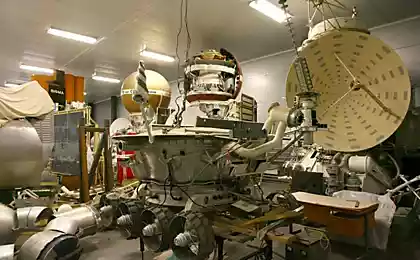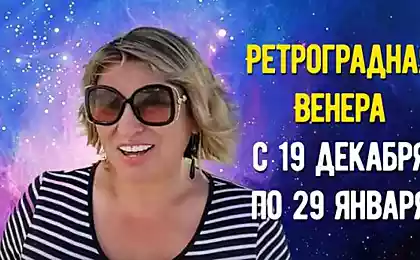973
Soviet assault on Venus
Venus - a series of Soviet unmanned interplanetary spacecraft to study the planet Venus and space. Tough conditions on Venus, as well as the initial lack of reliable information on such parameters as temperature and pressure, greatly complicates the process of investigation of the planet. Landers first series even had buoyancy. The first flights they were unsuccessful - but it was the first in the history of humanity automatic interplanetary flights.
The first launches a distant planet took place in February 1961. Then it was not yet a tradition, but it starts already committed couples. On February 4, the first flight went Venusian station, made at OKB-1 to Sergei Pavlovich Korolev. Booster "Lightning" for the first time been able to bring the spacecraft into orbit, but the upper stage did not work, and the station, which was held on the documents as "the object 1VA" Venus is gone. If there was an emergency start, as it can be silent - the Soviet government really did not like to admit failure - but it was a satellite! And then in the TASS report was the world announced the launch of a heavy satellite weighing 6483 kg and with the successful performance of this scientific and technical problems. There is no other name he had, by the way, was not: found in some sources the name "Sputnik-7" was given by Western analysts, that is, "for certainty».
15 ph via russos

By the way, in many cases unjustified secrecy surrounding the Soviet space program, generates a huge amount of rumors and speculation. And after starting the "heavy satellite" February 4 in the west, many believed that Russian unsuccessfully launched a person into space.
And on February 12 in the second flight went 1VA station type. She was more fortunate - the rocket worked well, too, the upper stage, and Soviet newspapers appeared with the headline about the launch of the world's first interplanetary probe to Venus. (Later, in hindsight, she was given the name of "Venus-1».)
At the time, scientists' ideas about Venus were very scarce and contradictory. Seriously consider the hypothesis that the surface is covered by ocean, so the first Soviet spacecraft to Venus calculated on the splashdown. Their design included "sugar castle" - the sugar had melted in the water, and then disclosed antennas lander - a Soviet pennant was made in the form of spheres, ability to swim in the ocean. How do these ideas were wrong ...
But the 'Venera-1 "and did not reach to his goal. The second and last session it held on 17 February at a distance of 1.9 million km from Earth, March 3 unit was presumed dead. May 19 silent unmanaged station passed at a distance of 100 thousand. Km of Venus.
New space probes sent to Venus in every astronomical startup screen (that is favorable relative positions of Earth and Venus, so the flight was the lowest energy consumption, for Venus, this period is about 19 months), but Venusian program pursued a series of misfortunes:
Three of the family unit WW2, two landing and one orbiting, were lost in accidents in the autumn of 1962 - August 25, 1 and 12 September. In all three cases did not load upper stage A, the fourth stage of "Lightning". No ads on missile has not been published, and the American and British catalogs supplemented by "satellite" with the numbers 19, 20 and 21. But in this astronomical window fortunate Americans - Mariner 2 passed in December, Venus and transmitted data capture and remote sensing.
The first device type 3mV it was decided to launch the window is astronomical, November 11, 1963, to test the station and technologies flight to Venus. Alas, the station was again left in Earth orbit. It was officially named "Space-21", but the report did not Tass said, as usual, all of the machine work normally, and the program runs successfully.
The second experimental apparatus was killed because of an accident rocket "Lightning" February 19, 1964 The first full-time station 3mV family remained in Earth orbit 27 March 1964 under the name of "Cosmos-27". At this time, masking was complete - Tass reported that the whole installed on-board equipment is working nominally.
The relative success came April 2, 1964, when the left side of Venus "The probe-1." From the very beginning has been registered leaks spacecraft orbital module, the unit was doomed - because he, in fact, did not give the name of "Venus." However, almost two months in touch with him managed to maintain through the transmitter lander, May 14 was even the correction trajectory. Communication stopped May 25, 1964, the station passed Venus already dead.
Fourth astronomical window "opened" at the end of 1965. It finally came the long-awaited success! AMC "Venera-2" and "Venera-3" successfully hit the road 12 and 16 November 1965 to the spring of the following year to reach a distant planet. No luck only the third station, the remaining launches in the table under the name of "Kosmos-96».
But again, fate turned us upside down! "Venera-2", despite the overheating of the receiver and bad passing teams in the 26 communication sessions, brought almost to Venus. February 27, 1966 she had to pass by the planet and shoot it from a distance of 24 thousand. Km. Alas, she sent the program of work for the day of flight station has not received and no data on Venus is not transmitted.
Even more offensive was the loss of "Venus-3." Yes, the first time in history a spacecraft created in the world, reached the other planets, and came into its atmosphere. On approaching "Venera-3" lander separated spherical diameter of 0, 9 m with insulation liner, equipped with a radio system, scientific instruments. He also carried a special pennant, which was to take on the planet. The lander entered the atmosphere of Venus March 1, 1966 - but the last and most important communication has failed, and no information about his fate has not been received.
Finally, the first truly great success of the USSR was the interplanetary station "Venera-4" (its lander you can see in the photo on the left), launched June 12, 1967. Unlike previous stations "Venera-4" and its unfortunate twin "Cosmos-167" (of course you can guess what happened to him) was made George N. Babakina team at an engineering plant named after Lavochkin. < br />
"Venera-4" reached its goal on 18 October. Lander with a set of scientific equipment safely separated for the first time in the history of space exploration conducted direct measurements of the composition of the atmosphere of Venus during the descent by parachute in it. The lander can operate at temperatures up to + 425 ° C and pressures up to 10 atmospheres, and to increase the chances of success, he parachuted to the night side of the planet. Before the start, he has been subjected to sterilization in order to prevent the transfer of terrestrial organisms to Venus.
The signal is stopped suddenly after 95 minutes after the start of the descent, at 25-26 km below the starting point, when behind it was + 280 ° C or 15 atmospheres. At first everyone thought that this was the moment of landing and that "Venus-4" managed to reach the surface in a working condition. And only a few weeks after comparisons of the data, "Venus-4" with measurements from the American Mariner Station 5, which passed the planet on October 19 it became clear that it was a mistake. In fact, at an altitude of about 28 km apprarat was crushed by atmospheric pressure was much more than envisaged in the design.
In the next window, 5 and 10 January 1969, on a flight headed two stations: "Venus-5" and "Venus-6". For the first time, both start-up went well, and the two went to the AMC on a course to Venus. By design, they are similar to "Venus-4", except for the descent module, which was designed to operate at pressures up to 25 atmospheres. In good, this was not enough, but a major upgrade was not enough time.
Both stations have reached the planet and dropped landers: "Venus-5" target reached May 16, 1969, and "Venus-6" - 17 May. After opening the parachute at the landers included scientific instruments and starts transmitting scientific data back to Earth. All parachute descent takes about 50 minutes, then at the height of 18 kilometers at a pressure of about 27 atmospheres, both the SA were crushed.
For measurements in the lower atmosphere and surface of Venus landers were necessary to withstand external pressures over 100 bar and have insulation that provides job-board equipment at an ambient temperature up to + 475 ° C.
"Venera-7", launched August 17, 1970 (the second station, which was launched on August 22 left in Earth orbit and received an official naming of "Cosmos-359"), designed and built based on the experience of previous operations of AMC. Lander (his cut - left) was designed from scratch, and he had to work at least 30 minutes on the surface at a temperature of up to + 540 ° C and a pressure of 150 atmospheres. Theoretical values obtained for the surface of the planet were: 500 ° C and 100 atmospheres, so that the parser has been constructed with a margin. Just fire case.
After 120 days after the start of 15 December 1970, "Venera-7" has reached the planet. Upon entering the atmosphere there was a division of the orbital and lander. During aerodynamic braking velocity of the vehicle relative to the planet decreased from 11 to 5 km / s to 200 m / s. The maximum overload of 350 units. At an altitude of about 55 km from the surface of Venus, when the external pressure of the order of 0, 7 atmosphere automation system implemented commissioning of the parachute.
December 15 at 8:00 34 minutes 10 seconds lander "Venera-7" for the first time in the world made a soft landing on the surface of Venus. In total it is transmitted to Earth information within 53 minutes, including about 20 minutes with the surface of Venus. Measured temperature at the surface of Venus was 475 ° ± 20 ° C; it corresponded to a pressure of 90 ± 15 atmospheres.
The next astronomical window on a long journey again went two stations. "Venus-8" was launched on 27 March 1972 and a copy of it - on March 31. The second launch, on a sad Venus "tradition" was unsuccessful. The first three stage rocket worked normally, ensuring the removal of the head unit to the reference near-Earth orbit, but on an interplanetary trajectory station did not come out as a result of the accident booster. The device, dubbed the "Cosmos-482" remains in Earth orbit.
Automatic station "Venus-8" on the goals and objectives of the flight almost completely repeated "Venera-7". As a result of the flight the previous station has been adjusted model of the atmosphere of the planet, which allowed to design new lander under real conditions with a small margin. Instead, the design pressure of 150 atmospheres was made 105 atmospheres, but instead of 540 ° - 493 ° C. Reducing the maximum values of temperature and pressure of the atmosphere of Venus has allowed to reduce the wall thickness of the instrument compartment SA, which made it possible to reduce the weight of the lander to 38, 5 kg.
In one of the laboratories of 601 minutes of chair is a copy of The prepared AMC "Venus-8". In its program design and we will dwell. And in the end, I will briefly discuss how to develop the program further Venusian.
Venera 8
After 117 days after the start of the July 22, 1972, the station "Venus-8" has reached the planet. When you enter the atmosphere of Venus from the station separated lander. The aerodynamic braking process in an atmosphere in which the machine is overloaded to 335 g, its speed is reduced from 11 to 6 km / s to 250 m / s, then at a height of ~ 55 km was put into action the parachute system. With the opening of the parachute started the transfer of scientific and service information.

After 55 minutes, a smooth descent by parachute under the machine landed on the illuminated side of Venus is 500 km from the morning terminator near the equator, the vertical velocity at the moment of contact was 8, 3 m / s. Radio reception and telemetry data continues for 50 minutes after landing. All this time, on-board systems and scientific instruments worked properly, which allowed to obtain full information not only about the atmosphere of Venus, but also on the conditions on the surface.
The flight program "Venera-8" has been fully implemented.

In order to determine the planet's surface illumination required for photographing her landers on the next generation of complex scientific equipment lander was supplemented photometer JOB 72. In addition to his CA was established different scientific equipment.

Filling AMC - a complex electronic circuit, where many operations are interconnected and automated. All this was done without any computers using a software-timing device.

SSP - on board the spacecraft electronic device for the issuing of control commands onboard systems at predetermined times. The program issuing commands (sequence and time intervals between them) can be set in advance (for example, in preparation for the flight), or specified in the flight from Earth by radio command; in the latter case, an apparatus for storing input program. SSP enables you to control the spacecraft in the absence of LOS, and in the intervals between sessions of radio communication with Earth.
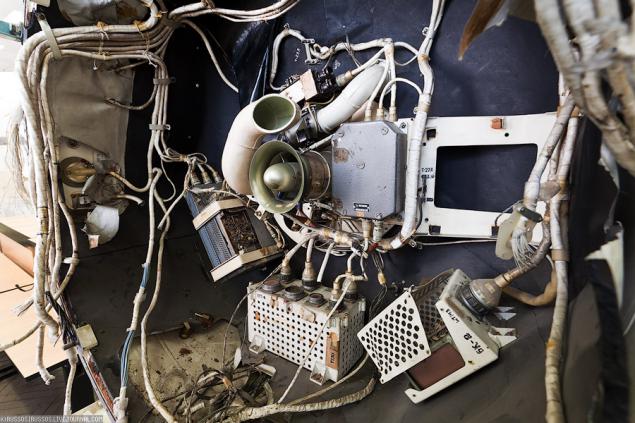
Thruster for orbit correction AMC for braking before entering the atmosphere of Venus.
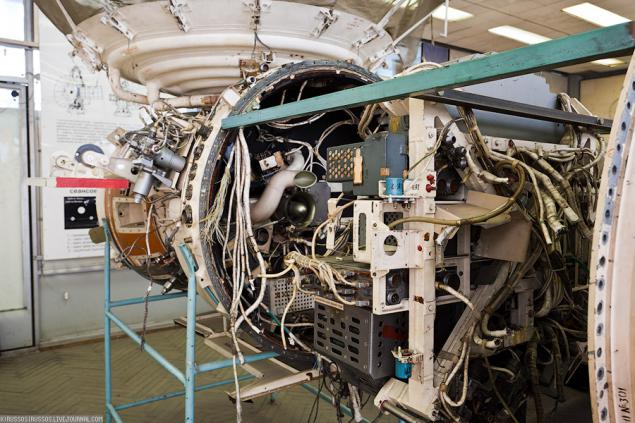
The unique information transmitted from the lander, "Venus-8", greatly expanded our knowledge of the planet Venus, including the conditions on its surface.

And so here, "Venus-8" appears in the laboratory. From left to right: the lander (a), gutted instrument compartment and engine compartment with the KDU. Top - a big antenna.

Some equipment.

And more wires, pipes and appliances.

Lander AMC family of "Venus." Presumably "Venera-7", but I'm very unsure.
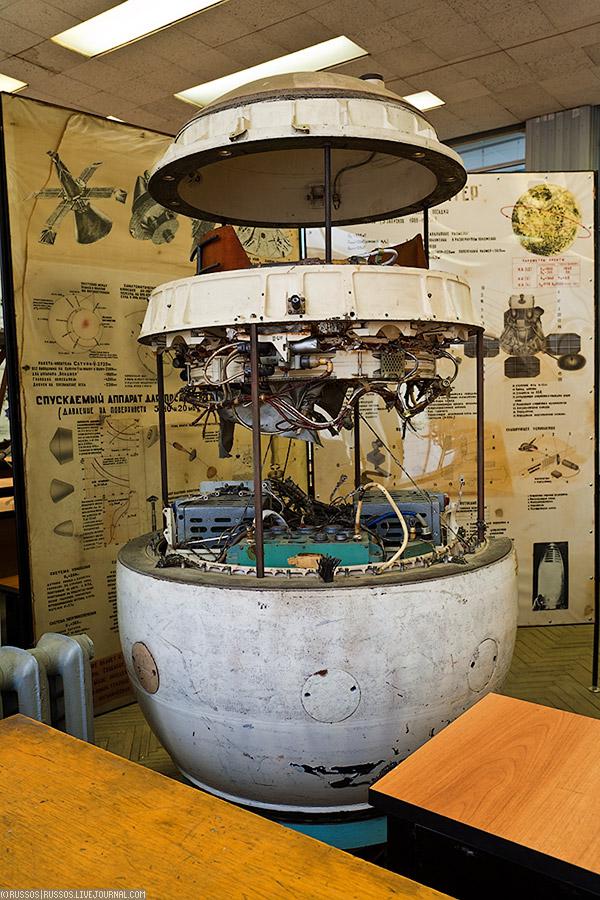
Lander "Venus-8" on the surface of the planet.
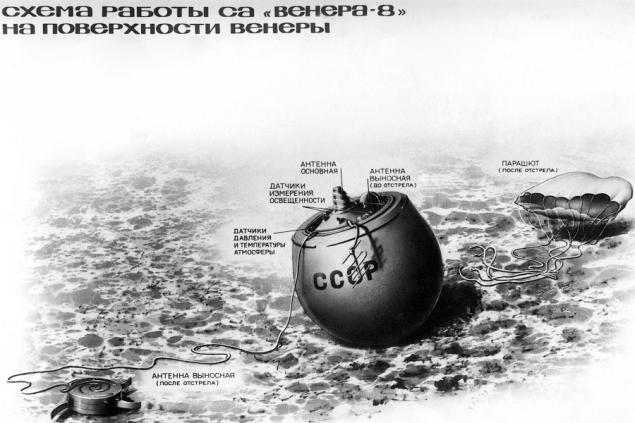
Fixed a photometer showed that illumination of the surface of Venus at the angle of the Sun 5 of 5 ° is 350 ± 150 lux, which indicates that the surface of the planet reaches only a small part of the solar radiation. If the sun is at its zenith, the illumination shall be not less than 1000-3000 lux, which is sufficient to produce facsimiles. Therefore, following the mission to Venus already had a task to make photography on its surface.
"Venus-8" was the last station of the first generation, designed for use PH "Lightning". The following devices have been designed for heavy "Proton". Because of this, in 1973 the astronomical window launches were not, and in June 1975 to Venus send two entirely new apparatus "Venera-9" and -10 & lt; / a & gt ;. Both start-up was successful, and in October reached the planet's surface vehicles, where the world's first passed phototelevision picture - Panorama.
Image with "Venus-9»

Soviet studies of Venus lasted until 1985, when landing on its surface landers carried AMC "Vega-1" and "Vega-2". In addition to the landers were launched balloon probes that drifted at an altitude of 50-60 kilometers. Each probe has worked about 46 hours, passing the path during this time 12 000 kilometers at an average speed of 250 km / h.
And in between, "Venus-8" and "Vegami" were launched AMC with atomic numbers 11-16 (and, emergency start was not there). Colorful panorama surface were first obtained on the "Venus» №№ 13 and 14; on them with the help of the drill they were taken and investigated soil samples. In "Venus-13" as the first sound recording was made on another planet - it turned out to be thunder. Two stations - "Venera-15" and -16 & lt; / a & gt; - Conducted a successful radar survey of Venus' surface from orbit with higher quality than to their American Pioneer Venus Orbiter.
Since 1985, the Soviet Union and Russia have not made any runs research Venus. Will they be in the near future - is unknown. In total, the Soviet Union was made 30 starts in the direction of the planet, of which can be considered successful 15.
Image with "Venus-10»

Source:
The first launches a distant planet took place in February 1961. Then it was not yet a tradition, but it starts already committed couples. On February 4, the first flight went Venusian station, made at OKB-1 to Sergei Pavlovich Korolev. Booster "Lightning" for the first time been able to bring the spacecraft into orbit, but the upper stage did not work, and the station, which was held on the documents as "the object 1VA" Venus is gone. If there was an emergency start, as it can be silent - the Soviet government really did not like to admit failure - but it was a satellite! And then in the TASS report was the world announced the launch of a heavy satellite weighing 6483 kg and with the successful performance of this scientific and technical problems. There is no other name he had, by the way, was not: found in some sources the name "Sputnik-7" was given by Western analysts, that is, "for certainty».
15 ph via russos

By the way, in many cases unjustified secrecy surrounding the Soviet space program, generates a huge amount of rumors and speculation. And after starting the "heavy satellite" February 4 in the west, many believed that Russian unsuccessfully launched a person into space.
And on February 12 in the second flight went 1VA station type. She was more fortunate - the rocket worked well, too, the upper stage, and Soviet newspapers appeared with the headline about the launch of the world's first interplanetary probe to Venus. (Later, in hindsight, she was given the name of "Venus-1».)
At the time, scientists' ideas about Venus were very scarce and contradictory. Seriously consider the hypothesis that the surface is covered by ocean, so the first Soviet spacecraft to Venus calculated on the splashdown. Their design included "sugar castle" - the sugar had melted in the water, and then disclosed antennas lander - a Soviet pennant was made in the form of spheres, ability to swim in the ocean. How do these ideas were wrong ...
But the 'Venera-1 "and did not reach to his goal. The second and last session it held on 17 February at a distance of 1.9 million km from Earth, March 3 unit was presumed dead. May 19 silent unmanaged station passed at a distance of 100 thousand. Km of Venus.
New space probes sent to Venus in every astronomical startup screen (that is favorable relative positions of Earth and Venus, so the flight was the lowest energy consumption, for Venus, this period is about 19 months), but Venusian program pursued a series of misfortunes:
Three of the family unit WW2, two landing and one orbiting, were lost in accidents in the autumn of 1962 - August 25, 1 and 12 September. In all three cases did not load upper stage A, the fourth stage of "Lightning". No ads on missile has not been published, and the American and British catalogs supplemented by "satellite" with the numbers 19, 20 and 21. But in this astronomical window fortunate Americans - Mariner 2 passed in December, Venus and transmitted data capture and remote sensing.
The first device type 3mV it was decided to launch the window is astronomical, November 11, 1963, to test the station and technologies flight to Venus. Alas, the station was again left in Earth orbit. It was officially named "Space-21", but the report did not Tass said, as usual, all of the machine work normally, and the program runs successfully.
The second experimental apparatus was killed because of an accident rocket "Lightning" February 19, 1964 The first full-time station 3mV family remained in Earth orbit 27 March 1964 under the name of "Cosmos-27". At this time, masking was complete - Tass reported that the whole installed on-board equipment is working nominally.
The relative success came April 2, 1964, when the left side of Venus "The probe-1." From the very beginning has been registered leaks spacecraft orbital module, the unit was doomed - because he, in fact, did not give the name of "Venus." However, almost two months in touch with him managed to maintain through the transmitter lander, May 14 was even the correction trajectory. Communication stopped May 25, 1964, the station passed Venus already dead.
Fourth astronomical window "opened" at the end of 1965. It finally came the long-awaited success! AMC "Venera-2" and "Venera-3" successfully hit the road 12 and 16 November 1965 to the spring of the following year to reach a distant planet. No luck only the third station, the remaining launches in the table under the name of "Kosmos-96».
But again, fate turned us upside down! "Venera-2", despite the overheating of the receiver and bad passing teams in the 26 communication sessions, brought almost to Venus. February 27, 1966 she had to pass by the planet and shoot it from a distance of 24 thousand. Km. Alas, she sent the program of work for the day of flight station has not received and no data on Venus is not transmitted.
Even more offensive was the loss of "Venus-3." Yes, the first time in history a spacecraft created in the world, reached the other planets, and came into its atmosphere. On approaching "Venera-3" lander separated spherical diameter of 0, 9 m with insulation liner, equipped with a radio system, scientific instruments. He also carried a special pennant, which was to take on the planet. The lander entered the atmosphere of Venus March 1, 1966 - but the last and most important communication has failed, and no information about his fate has not been received.
Finally, the first truly great success of the USSR was the interplanetary station "Venera-4" (its lander you can see in the photo on the left), launched June 12, 1967. Unlike previous stations "Venera-4" and its unfortunate twin "Cosmos-167" (of course you can guess what happened to him) was made George N. Babakina team at an engineering plant named after Lavochkin. < br />
"Venera-4" reached its goal on 18 October. Lander with a set of scientific equipment safely separated for the first time in the history of space exploration conducted direct measurements of the composition of the atmosphere of Venus during the descent by parachute in it. The lander can operate at temperatures up to + 425 ° C and pressures up to 10 atmospheres, and to increase the chances of success, he parachuted to the night side of the planet. Before the start, he has been subjected to sterilization in order to prevent the transfer of terrestrial organisms to Venus.
The signal is stopped suddenly after 95 minutes after the start of the descent, at 25-26 km below the starting point, when behind it was + 280 ° C or 15 atmospheres. At first everyone thought that this was the moment of landing and that "Venus-4" managed to reach the surface in a working condition. And only a few weeks after comparisons of the data, "Venus-4" with measurements from the American Mariner Station 5, which passed the planet on October 19 it became clear that it was a mistake. In fact, at an altitude of about 28 km apprarat was crushed by atmospheric pressure was much more than envisaged in the design.
In the next window, 5 and 10 January 1969, on a flight headed two stations: "Venus-5" and "Venus-6". For the first time, both start-up went well, and the two went to the AMC on a course to Venus. By design, they are similar to "Venus-4", except for the descent module, which was designed to operate at pressures up to 25 atmospheres. In good, this was not enough, but a major upgrade was not enough time.
Both stations have reached the planet and dropped landers: "Venus-5" target reached May 16, 1969, and "Venus-6" - 17 May. After opening the parachute at the landers included scientific instruments and starts transmitting scientific data back to Earth. All parachute descent takes about 50 minutes, then at the height of 18 kilometers at a pressure of about 27 atmospheres, both the SA were crushed.
For measurements in the lower atmosphere and surface of Venus landers were necessary to withstand external pressures over 100 bar and have insulation that provides job-board equipment at an ambient temperature up to + 475 ° C.
"Venera-7", launched August 17, 1970 (the second station, which was launched on August 22 left in Earth orbit and received an official naming of "Cosmos-359"), designed and built based on the experience of previous operations of AMC. Lander (his cut - left) was designed from scratch, and he had to work at least 30 minutes on the surface at a temperature of up to + 540 ° C and a pressure of 150 atmospheres. Theoretical values obtained for the surface of the planet were: 500 ° C and 100 atmospheres, so that the parser has been constructed with a margin. Just fire case.
After 120 days after the start of 15 December 1970, "Venera-7" has reached the planet. Upon entering the atmosphere there was a division of the orbital and lander. During aerodynamic braking velocity of the vehicle relative to the planet decreased from 11 to 5 km / s to 200 m / s. The maximum overload of 350 units. At an altitude of about 55 km from the surface of Venus, when the external pressure of the order of 0, 7 atmosphere automation system implemented commissioning of the parachute.
December 15 at 8:00 34 minutes 10 seconds lander "Venera-7" for the first time in the world made a soft landing on the surface of Venus. In total it is transmitted to Earth information within 53 minutes, including about 20 minutes with the surface of Venus. Measured temperature at the surface of Venus was 475 ° ± 20 ° C; it corresponded to a pressure of 90 ± 15 atmospheres.
The next astronomical window on a long journey again went two stations. "Venus-8" was launched on 27 March 1972 and a copy of it - on March 31. The second launch, on a sad Venus "tradition" was unsuccessful. The first three stage rocket worked normally, ensuring the removal of the head unit to the reference near-Earth orbit, but on an interplanetary trajectory station did not come out as a result of the accident booster. The device, dubbed the "Cosmos-482" remains in Earth orbit.
Automatic station "Venus-8" on the goals and objectives of the flight almost completely repeated "Venera-7". As a result of the flight the previous station has been adjusted model of the atmosphere of the planet, which allowed to design new lander under real conditions with a small margin. Instead, the design pressure of 150 atmospheres was made 105 atmospheres, but instead of 540 ° - 493 ° C. Reducing the maximum values of temperature and pressure of the atmosphere of Venus has allowed to reduce the wall thickness of the instrument compartment SA, which made it possible to reduce the weight of the lander to 38, 5 kg.
In one of the laboratories of 601 minutes of chair is a copy of The prepared AMC "Venus-8". In its program design and we will dwell. And in the end, I will briefly discuss how to develop the program further Venusian.
Venera 8
After 117 days after the start of the July 22, 1972, the station "Venus-8" has reached the planet. When you enter the atmosphere of Venus from the station separated lander. The aerodynamic braking process in an atmosphere in which the machine is overloaded to 335 g, its speed is reduced from 11 to 6 km / s to 250 m / s, then at a height of ~ 55 km was put into action the parachute system. With the opening of the parachute started the transfer of scientific and service information.

After 55 minutes, a smooth descent by parachute under the machine landed on the illuminated side of Venus is 500 km from the morning terminator near the equator, the vertical velocity at the moment of contact was 8, 3 m / s. Radio reception and telemetry data continues for 50 minutes after landing. All this time, on-board systems and scientific instruments worked properly, which allowed to obtain full information not only about the atmosphere of Venus, but also on the conditions on the surface.
The flight program "Venera-8" has been fully implemented.

In order to determine the planet's surface illumination required for photographing her landers on the next generation of complex scientific equipment lander was supplemented photometer JOB 72. In addition to his CA was established different scientific equipment.

Filling AMC - a complex electronic circuit, where many operations are interconnected and automated. All this was done without any computers using a software-timing device.

SSP - on board the spacecraft electronic device for the issuing of control commands onboard systems at predetermined times. The program issuing commands (sequence and time intervals between them) can be set in advance (for example, in preparation for the flight), or specified in the flight from Earth by radio command; in the latter case, an apparatus for storing input program. SSP enables you to control the spacecraft in the absence of LOS, and in the intervals between sessions of radio communication with Earth.

Thruster for orbit correction AMC for braking before entering the atmosphere of Venus.

The unique information transmitted from the lander, "Venus-8", greatly expanded our knowledge of the planet Venus, including the conditions on its surface.

And so here, "Venus-8" appears in the laboratory. From left to right: the lander (a), gutted instrument compartment and engine compartment with the KDU. Top - a big antenna.

Some equipment.

And more wires, pipes and appliances.

Lander AMC family of "Venus." Presumably "Venera-7", but I'm very unsure.

Lander "Venus-8" on the surface of the planet.

Fixed a photometer showed that illumination of the surface of Venus at the angle of the Sun 5 of 5 ° is 350 ± 150 lux, which indicates that the surface of the planet reaches only a small part of the solar radiation. If the sun is at its zenith, the illumination shall be not less than 1000-3000 lux, which is sufficient to produce facsimiles. Therefore, following the mission to Venus already had a task to make photography on its surface.
"Venus-8" was the last station of the first generation, designed for use PH "Lightning". The following devices have been designed for heavy "Proton". Because of this, in 1973 the astronomical window launches were not, and in June 1975 to Venus send two entirely new apparatus "Venera-9" and -10 & lt; / a & gt ;. Both start-up was successful, and in October reached the planet's surface vehicles, where the world's first passed phototelevision picture - Panorama.
Image with "Venus-9»

Soviet studies of Venus lasted until 1985, when landing on its surface landers carried AMC "Vega-1" and "Vega-2". In addition to the landers were launched balloon probes that drifted at an altitude of 50-60 kilometers. Each probe has worked about 46 hours, passing the path during this time 12 000 kilometers at an average speed of 250 km / h.
And in between, "Venus-8" and "Vegami" were launched AMC with atomic numbers 11-16 (and, emergency start was not there). Colorful panorama surface were first obtained on the "Venus» №№ 13 and 14; on them with the help of the drill they were taken and investigated soil samples. In "Venus-13" as the first sound recording was made on another planet - it turned out to be thunder. Two stations - "Venera-15" and -16 & lt; / a & gt; - Conducted a successful radar survey of Venus' surface from orbit with higher quality than to their American Pioneer Venus Orbiter.
Since 1985, the Soviet Union and Russia have not made any runs research Venus. Will they be in the near future - is unknown. In total, the Soviet Union was made 30 starts in the direction of the planet, of which can be considered successful 15.
Image with "Venus-10»

Source:












